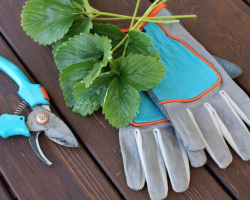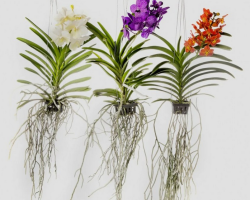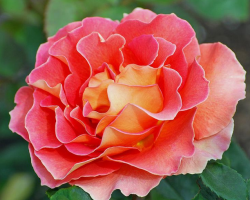You have an orchid, but you don’t know how to transplant it at home? Read the article, it has many useful tips and instructions.
Content
- Why transplant an orchid when growing at home: are they transplanted at all, is it possible?
- Dates: When can I transplant the orchid?
- The frequency of the orchid transplant at home: how often?
- The substrate for the orchid transplant at home: what are they making?
- In which pot is better to transplant a home orchid?
- How to properly transplant an orchid at home at another, new pot: methods and technology step by step, photo, video
- Video: We transplant an orchid. I share my experience
- How to transplant children, one baby, a process of home orchid: instructions step by step
- Further proper care of the plant of the phalaenopsis orchid after transplanting, the growing conditions
- In the absence of flowering after transplantation: what to do?
- What to do if the home orchid withered after the transplant?
- How to water the home flower orchid?
- Features of the transplant of the orchid flower at home: new after purchase in the store, in the spring, in a glass vase, an old flower
- Video: Planting an orchid in a glass pot
- How to transplant a flower orchid if the root is bored: tips
- Is it possible to transplant a flowering orchid during flowering?
- How to transplant a flower orchid in a pot: Video
- Video: Orchids easily transplant - detailed video transplantation of phalaenopsis
- Video: resuscitation of orchids, orchids without roots - how to plant?
The orchid, just like a rose, can be called queen. Graceful flowers, decorative leaves, intertwined roots and stems, create a plant of incredible beauty. But this flower, like everyone else, needs good care, an important component of which is a transplant. It must be done correctly and on time - the further development of the plant and the abundance of flowering, as well as the duration of the adaptation process, depend on this.
Read another article on our website, which is told, how to propagate an orchid at home by children, cuttings, roots, seeds. All methods are described in detail.
This article describes the deadlines, as well as the rules for the transplantation of the home orchid. You will learn how to transplant a flower after the store and why do it at all. Read further.
Why transplant an orchid when growing at home: are they transplanted at all, is it possible?

Different circumstances may arise in which a transplant is made. Why transplant an orchid when growing at home? Do they transplant at all, is it possible? Yes, this can and should be done. Here are the circumstances in which flowers breeding experts advise doing this:
- The transplant is mandatory once in 3-4 years After buying or transplanting plants.
- If it is noticed that the roots began to show from the pot, i.e. He became small for the plant.
- If the orchid is very sick, it began to yellow all the leaves.
- The unsightly appearance and condition of the substrate in which the flower grows. On the surface appeared mold or severe dryness of the upper fragments, which indicates the loss of the ability to fill water and air.
- The plant does not bloom for several years, and then it needs a good shake in the form of a transplant.
- If it is necessary to separate the orchid.
If these signs are not observed, it is better not to touch the orchid - she does not really like to be worried. It is also not recommended to do this during the flowering process, it is better to wait until it ends, unless an urgent transplant is needed.
Dates: When can I transplant the orchid?

This operation needs to be carried out when the rest period for inflorescences and the entire plant ends. But there are types of orchids in which the rest period is weakly expressed, for example, in Falanopsis, blooming almost all year round with small breaks. Therefore, if new shoots in the plant do not develop in the absence of signs of the disease, it means that it enters during the rest. This is the right time for transplanting. Usually this time is in spring - the end of February and March. These are the best terms when you can transplant an orchid.
The frequency of the orchid transplant at home: how often?

Many beginner flowers are wondering: "How often to transplant the orchid?". What depends on the frequency of transplanting inflorescences at home?
- The answer to this question depends on which composition of the substrate is in the container.
- It can consist of moss, and then you need to transplant more often - once every two years.
- If the main part of the substrate is the bark, which decomposes slower, then you can transplant once every three years.
Of course, these terms are indicated for planned transplantings, when the inflorescence looks completely healthy and does not have signs of insect damage.
The substrate for the orchid transplant at home: what are they making?

For transplanting orchids at home, you need to choose a high -quality substrate. The health and further process of plant flowering largely depends on this. What is it made of? In retail outlets you can buy specialized, but it can be of two types:
- For epiphytic (i.e. with air roots). Called "A mixture for phalaenopsis."
- For ground - "A mixture for zimbidium."
The first mixture is used for flowers growing on trees with long air roots. Therefore, the substrate for them should be breathable, because the roots of these colors take part in photosynthesis and they do not need soil for growth, only moisture. These mixtures usually include:
- Pine bark
- The crushed root of the fern
- Activated carbon
- Cut traffic jam
- Sphagnum in small quantities
The second type of mixture is more dense, because It is intended for orchids living on Earth. It has more such ingredients:
- The moss of sphagnum
- Lowland peat
- Leaf land
- Coal
Sometimes various synthetic materials are used as a substrate, for example, perlite or polystyrene. You can also use:
- Keramzit
- Shell
- Pumzu
The substrate can be made at home. For this, a pine bark is used:
- Divide it first - hold it over the steam for half an hour or boil in water.
- After that, dry and boil again. With this processing, all pathogenic organisms die.
- Put on drying again and then cut into pieces with length up to 2 cm.
Add the dry and finely chopped sphagnum and very little peat coal to the bark prepared in this way. This mixture can already fill the pots.
In which pot is better to transplant a home orchid?

Orchids in the majority have large roots that like to braid the pot from the inside and even peep out. Therefore, when choosing a new container for a flower, you need to focus primarily on the size of the root system. But, given that the base of the flower will grow further, you need to add a few centimeters to the diameter. In which pot is better to transplant a home orchid?
It is worth knowing: For a large orchid with intensive growth, you can buy a pot, as they say "for growth" so as not to transplant it often.
Fans of orchids most often grow their “beauties” in plastic transparent pots or containers. What are the advantages of just such containers? Here's the answer:
- The roots are clearly visible and you can constantly monitor their condition. With normal soil moisture, the roots usually have a green color, but as the substrate dries, they gradually become gray, which indicates the need for irrigation.
- In plastic containers, unlike clay, the roots do not grow to the attenuations of the container and therefore are not injured during transplantation.
Although clay containers have their advantages:
- In them, the base-root does not overheat, which is very relevant for orchids.
- Do not pour the plant, because moisture lasts longer.
- In addition, the clay pot is much harder than plastic and therefore it will not turn over. Orchids are planted in such pots, part of the roots of which during the rest completely dry and dies.
Be sure to make drainage holes in containers. This will provide the roots with faster drying and ventilation, which will protect them from decay. Specialists of flowers without experience often pour the plant, afraid to dry it. Drainage holes will help in this case.
It is worth knowing: Plastic containers have one drawback - they have quite simple, not quite exquisite, compared with the flower itself, a species. To fix this drawback, you can buy a beautiful pot, which will completely hide plastic.
There is another way out - you can put a plastic pot in a low glass vase. The space between the walls of the vase and the pot is filled with some jewelry or tinsel, balls or floral fillers. This must be done carefully so that the multi -colored filler does not distract from the beauty of the colors of the orchid.
Remember: For orchids, do not buy large containers. In the little ones - to 15 cm In diameter, she feels much better and blooms longer.
How to properly transplant an orchid at home at another, new pot: methods and technology step by step, photo, video

So, the decision on transplantation has been made. How to act? How to properly transplant an orchid at home in another, new pot? Here are methods and technology step by step with photo:

- Put the container with the plant in a cup of water so that the substrate is well foured by liquid and it can be easily extracted from the container.
- Now you need to carefully shake the inflorescence from the container and shake off all fragments of the substrate from the roots.

- Inspect the roots and cut off rotten and hollow branches. Then rinse them well under running warm water.

- Put on a dry rag or paper and let dry.
- When the roots become dry, sprinkle the places of cuts with interpreted activated coal.

- Pour a little with a slide into the pot on the drainage layer and place the roots on it, supporting with one hand. Gradually add a new substrate to the top, slightly shaking the pot so that the mixture is more evenly distributed.

- It is necessary to ensure that the root neck of the plant is exactly at the level of the upper part of the substrate and was not buried.
That's all - it remains to put an orchid on a light windowsill or a nightstand near the window, but not to direct sunlight. It is not necessary to water the inflorescence after a transplant. Watch more in the video how the flower grower transplants the flower and shows and tells everything.
Video: We transplant an orchid. I share my experience
How to transplant children, one baby, a process of home orchid: instructions step by step

An orchid, growing in normal, ideal conditions, can give young processes, or children. This is a great opportunity to propagate the plant. What should be done? How to transplant children, one baby, a process of a domestic orchid? Here are the instructions step by step:
- The baby should have quite long roots - more than 5 cm and 3-4 leaflets - These are the most suitable parameters for transplantation.
- Children usually appear on a stem or near the root neck. With a sharp knife, you need to cut off part of the stem with the baby, retreating to the sides about 1 cm. Sprinkle the cut place with coal.
- Prepare a small glass in advance, it is better to plastic, and pour a small layer of drainage.
- Place the baby in a glass and carefully fill up with a substrate. First 3-4 days Do not water.
- Place a glass with a baby in a place where air humidity is increased. You can simply spray the surface of the windowsill more often where the glass is worth. Try not to get on the leaves.
In this container, the baby will grow for about a year, after which it can be transplanted into a larger container. The orchid grown from the baby will bloom in three years.
Further proper care of the plant of the phalaenopsis orchid after transplanting, the growing conditions
After transplanting, it is necessary to ensure the correct and timely further care of the orchid. Here are the conditions for growing the plant of the phalaenopsis orchid:

- As mentioned above, immediately after transplanting, a container for a week is placed on a sunny windowsill, but shade from direct sunlight. In another case, if this is not done, the leaves of the orchids lose their decorative appearance, wrinkle and bind.

- Pour the plant after transplanting You can only in 2 weeks. The fact is that orchid roots are susceptible to various fungal diseases. Therefore, the root system must be slightly dried to avoid this. Find out, how to water the orchid here correctly.

- But in order not to dry the plant, organize spraying the leaves, or, better, wipe them with a wet sponge. In this case, water should in no case fall into the depths of the leaves of the leaves. This can lead to rotting them.

- It is important to maintain the optimum temperature. Orchid does not like heat, she needs temperature not higher than +21-22 ° Cbut she should not fall below 18 ° C. Otherwise, inflorescences are stressed, which is very undesirable for these non -wings.

- The flowering orchid needs top dressing. Use only mineral mixtures. Organic for feeding colors are not suitable, since they can be brought into the soil of the disease.
Excessive nitrogen nutrition can cause the growth of leaflets to the detriment of flowering. Now in stores you can find special fertilizers for orchids. In any case, it will be good to use universal fertilizer for flowering plants. They need to be diluted strictly according to the instructions so as not to harm the flower. You need to make them along with water for watering.
In the absence of flowering after transplantation: what to do?

After the transplantation, the orchid should increase the green mass and bloom after a certain time. This usually happens after 3-4 months. But what if inflorescences do not appear much longer? What to do in the absence of flowering after transplantation? Such a problem may arise for several reasons:
- The plant is overfed with nitrogen fertilizers, there is an active growth of leaves, they become more than they should be with normal development. In this case, top dressing must be stopped for a month.
- The transplant was not made in a timely manner. For example, if for some reason the orchid was transplanted in those terms when it bloomed last year, then this year it will most likely not bloom. The plant will direct all the forces to restore its root system, and not to flowering.
- Perhaps you made errors when transplanting. If the plant is not well fixed in the substrate, then when moving the pot, it begins to hang out in it, while the roots and stems will receive microtrauma. The plant is not able to direct strength to flowering, experiencing constant stress.
- Insufficient lighting with low humidity. It is necessary to rearrange the pot to a lighter windowsill and spray its surface to increase the humidity of the surrounding air.
Follow these tips, and your flower will soon please with its unique flowering. Worse, when the plant begins to fade. What to do? Read further.
What to do if the home orchid withered after the transplant?

Most likely the plant fell ill. In case of violation of landing rules, when mechanical damage to the roots occurs, the leaves do not get in full food. What to do if the home orchid withered after the transplant? Here are the tips:
If you watered a lot, transplant the plant:
- With good watering and stagnation at the bottom of the container, especially if there is no drainage, the roots may begin to rot.
- Then the wilting will soon change the yellowing of the leaves and the plant may die.
- It will be needed here emergency transplant Orchids to save her.
Drive the fight against pests:
- Another reason may be the attack of pests.
- In dry air, spider mites, the most malicious pests of indoor plants feel well.
- It can be difficult to notice them right away - they are very small and bad effects begin to appear when there are many of them.
- Belklak and shields also harm orchids. Significantly reduce the number of these insects will help ensure the optimal humidity.
Put from the sun:
- If the orchid is not protected from direct sunlight, its leaves will begin to fade.
- Best of all, such an indoor flower feels on the windows that exit east, where the sun appears only in the morning and for a short while.
The containers should be provided with drainage holes, and they need to be made not only in the lowest part of the container, but also on the sides in order to provide the roots with good air exchange.
How to water the home flower orchid?

Watering the homemade flower orchid is carried out by immersion in water, the temperature of which not lower than +20 ° Cso as not to cause stress in the plant. How to do it right? Here's the answer:
- To do this, take a cup with a warm liquid and put a container with a plant in it for 20 minutes.
- Then take it out and put it on the lattice to excess glass of glass.
- Then place the flower in the usual place.
In winter, the amount of watering must be reduced, and in the summer, on the contrary, this must be done more often, at least twice a week. It is necessary to monitor pseudobulbo - if it has lost a turgor, then watering is necessary.
Important: It is forbidden to take large breaks between watering. An orchid tropical plant, in nature living during frequent rains and increased humidity. Therefore, drought for her is destructive.
Features of the transplant of the orchid flower at home: new after purchase in the store, in the spring, in a glass vase, an old flower
It is important to be able to transplant a flower. If you do everything correctly, then the orchid will delight with its unique flowering. Here are the features of the transplant of the orchid flower at home:

New flower after buying in a store or spring:
- Usually, flowering orchids are sold in the store, as they say, to show the goods with a face.
- After the purchase was made and the container with a flower took its place on the windowsill, you need to evaluate its appearance.
- As a rule, orchids are sold in nondescript plastic containers, which does not correspond to the luxurious appearance of the flower itself.
- But do not rush and only because of this to transplant it into another pot.
- Wait for the end of the flowering process and after the plant begins to enter during the rest, transplant it into a more beautiful pot. You also need to do in the spring months. When the inflorescence ceases to bloom, you can start a transplant.
- If in a container with a purchased orchid, the roots are very actively beginning to get out of the container and grow in all directions, then you can try to shift the plant into a more spacious pot. But the risk of introducing a flower into a state of stress is high here. He can simply drop inflorescences and bloom only next year.

In a glass vase:
- Some experienced orchid lovers grow them in beautiful glass vases.
- There are no drainage holes in them, but experienced flower growers are able to determine by some signs the moment when the plant needs to be watered.
- A feature of the use of glass pots is a large layer of drainage at the bottom, which can protect the roots from random overflow.

Old flower:
- There are features in the transplant of the old plant.
- If in nature the orchid lives for a long time - before 80 or more years, then in indoor - no more than 10 years.
- For such plants, you can conduct anti -aging transplant. It is also produced during the rest.
- The substrate and selection of containers are made according to the same parameters as for ordinary transplantation.
Instructions, what to do next:
- Gently pull the orchid out of the old pot.
- Clean the roots, dry and rotten delete.
- Then rinse them in warm water and sprinkle the sections with coal.
- Now you need to choose on the barrel the place where the incision will be made. Usually the old orchids over the root neck or directly from the leaf outlet - new roots are produced and a young plant forms there. So you need to carefully separate it with a sharp knife from the old stem.
- Process the cuts with coal and dry well during the day.
Put the separated parts in new pots without deepening the root neck, and then act as in a conventional transplant.
Video: Planting an orchid in a glass pot
How to transplant a flower orchid if the root is bored: tips

Infrequently, but there are times when novice flower growers as a result of improper care, the roots of the orchid rot. This can happen at once with all the roots or with a large part of them. Is it possible to save the plant then? How to transplant a flower orchid if the root has been extended? Here are the tips:
- To reanimate the orchids, who have completely died the roots, we need a small window greenhouse.
- In the container where the leaf outlet will be located, you need to pour a small layer of drainage - it can be expanded clay or pebbles.
- Lay the sphagnum on top, which is previously kept over the steam and dried.
- Now moisten the substrate and place a leaf outlet in it.
- Transfer to a greenhouse where a constant temperature should remain within the limits +21 - +27 ° C And high humidity about 100%. The light should be bright, but scattered - direct sunlight is destructive for leaves during this period.
Through 3-4 weeks This regime, at the base of the leaf outlet, will begin to appear rudiments of the roots and then they will begin to grow. To speed up this process, you can add growth regulator to water for watering, for example, "Epin", diluted strictly according to the instructions.
If the sick orchid has several living roots or even one, the chances of its salvation are increasing:
- After trimming the rotten roots under warm water, it is necessary to rinse the remaining living roots, and sprinkle the places of cuts with coal.
- Pre -prepared pot up to 8 cm In the diameter, they fill with an ordinary substrate and planted a leaf outlet with roots in it.
- Further, they come with the plant, as in the first case, placing it in a greenhouse.
If everything has passed successfully, new roots will begin to grow after 2-4 weeks.
Is it possible to transplant a flowering orchid during flowering?

There is only one situation in which you can transplant a flowering orchid-if it threatens to death for any reason and you need to choose one of two:
- The orchid will bloom, but then he will die, spending the last forces on flowering.
- The peduncle is briefly cut, but in the future with good care, the plant is completely restored and after a while it will bloom again.
What to do in the second case? Tips:
- Prepare a fresh substrate and pot. How to do this has already been said above in the text.
- In the orchid, cut the peduncles approximately 2/3 of the length. By the way, flowers can be put in water - they will stand for almost a week.
- Carefully pull the plant out of the pot and examine the roots, cutting out all the rotten.
- If the substrate is in normal condition, i.e. There is no mold or its smell, it is not overdried or, conversely, very waterlogging, then in this case you need to try to keep it as much as possible without brushing the roots. Otherwise, they act as a conventional transplant, the procedure of which has already been described.
- Now you need to place the plant in a pot and fix it well there.
It remains to put an orchid transplanted during flowering in a greenhouse and watch how it will feel further. Do not forget about the mandatory implementation of all rules for caring for this flower that are no more complicated than the rules for caring for other indoor colors.
How to transplant a flower orchid in a pot: Video
I so want the indoor plant to please with its unique flowering for a long time. But for this you need to take care of the flower and transplant. How to transplant an orchid into a pot? Watch the video. It tells in detail how to do this. In another video, the flower breeder shows how to reanimate the plant if it has no roots left.
Video: Orchids easily transplant - detailed video transplantation of phalaenopsis
Video: resuscitation of orchids, orchids without roots - how to plant?
Read on the topic of crop production:







